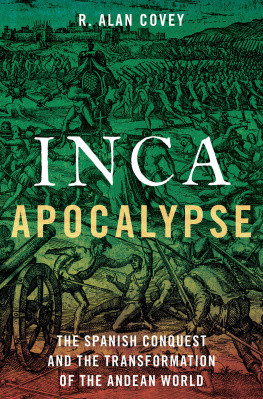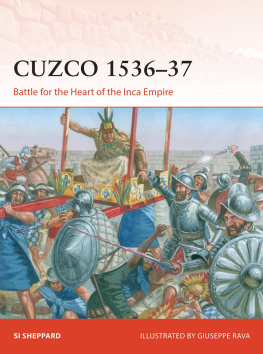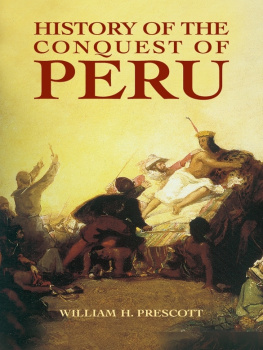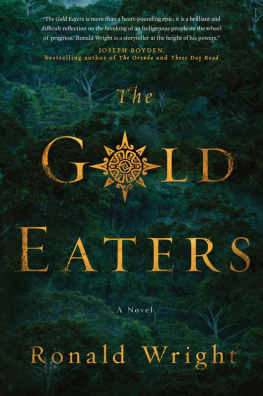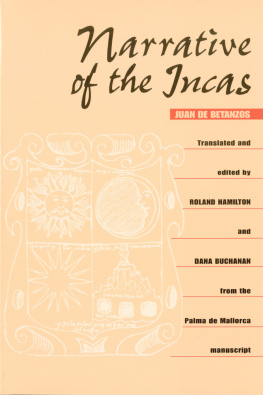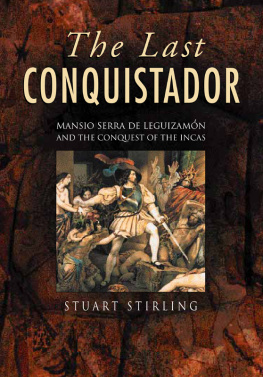
ALSO BY KIM MACQUARRIE
Gold of the Andes: The Llamas, Alpacas, Vicuas and Guanacos of South America
Perus Amazonian Eden: Manu National Park and Biosphere Reserve
Where the Andes Meet the Amazon
THE LAST DAYS OF THE INCAS
Kim MacQuarrie


SIMON & SCHUSTER
Rockefeller Center
1230 Avenue of the Americas
New York, NY 10020
www.SimonandSchuster.com
Copyright 2007 by Kim MacQuarrie All rights reserved, including the right of reproduction in whole or in part in any form.
SIMON & SCHUSTER and colophon are registered trademarks of Simon & Schuster, Inc.
For information about special discounts for bulk purchases, please contact Simon & Schuster Special Sales at 1-800-456-6798 or business@simonandschuster.com
Designed by Paul Dippolito
Manufactured in the United States of America
1 3 5 7 9 10 8 6 4 2
Library of Congress Cataloging-in-Publication Data
MacQuarrie, Kim
The last days of the Incas / Kim MacQuarrie.
p. cm.
Includes bibliographical references and index.
1. PeruHistoryConquest, 1522?1548. 2. Vilcabamba Site (Peru). I. Title.
F3442.M33 2007
98502dc22 2007061700
ISBN-13: 978-0-7432-6049-7
ISBN-10: 0-7432-6049-X
eISBN-13: 978-1-4165-3935-3
To my parents, Ron and Joanne MacQuarrie
CONTENTS


CHRONOLOGY OF EVENTS
1492 | Columbus lands in what is now called the Bahamas; this is the first of his four voyages to the New World. |
1502 | Francisco Pizarro arrives on the island of Hispaniola. |
15021503 | During his last voyage, Columbus explores the coasts of what will later be called Honduras, Nicaragua, Costa Rica, and Panama. |
1513 | Vasco Nez de Balboa and Francisco Pizarro cross the Isthmus of Panama and discover the Pacific Ocean. |
1516 | The future Inca emperor Manco Inca is born. |
15191521 | Hernando Corts conquers the Aztec Empire in Mexico. |
15241525 | Francisco Pizarros first voyage heads south from Panama and explores along the coast of Colombia. The trip is a financial failure. Pizarros colleague Diego de Almagro loses an eye in a battle with natives. |
1526 | Pizarro, Almagro, and Hernando de Luque form the Company of the Levant, a company dedicated to conquest. |
15261527 | Pizarro and Almagros second voyage. Pizarro makes his first contact with the Inca Empire at Tumbez. |
c. 1528 | The Inca Emperor Huayna Capac dies from European-introduced smallpox. His death sets off a civil war between his sons Atahualpa and Huascar. |
15281529 | Pizarro journeys to Spain, where he is granted a license to conquer Peru by the queen. |
15311532 | Pizarros third voyage to Peru. Pizarro captures Atahualpa. |
1533 | Atahualpa is executed; Almagro arrives; Pizarro captures Cuzco and installs seventeen-year-old Manco Inca as the new Inca emperor. |
1535 | Pizarro founds the city of Lima; Almagro leaves for Chile. |
1536 | Gonzalo Pizarro steals Manco Incas wife, Cura Ocllo. Manco rebels and surrounds Cuzco. Juan Pizarro is killed, and the Inca general Quizo Yupanqui attacks Lima. |
1537 | Almagro seizes Cuzco from Hernando and Gonzalo Pizarro. Rodrigo Orgez sacks Vitcos and captures Manco Incas son, Titu Cusi. Manco escapes and flees to Vilcabamba, the new Inca capital. |
1538 | Hernando Pizarro executes Diego de Almagro. |
1539 | Gonzalo Pizarro invades and sacks Vilcabamba; Manco Inca escapes but Francisco Pizarro executes Mancos wife, Cura Ocllo. |
1540 | Hernando Pizarro begins a prison sentence of twenty years in Spain. |
1541 | Francisco Pizarro is murdered by supporters of Almagro. One of his assassins, Diego Mndez, flees to Vilcabamba. |
1544 | Manco Inca is murdered by Diego Mndez and six renegade Spaniards. Gonzalo Pizarro rebels against the king of Spain. |
1548 | Battle of Jaquijahuana; Gonzalo Pizarro is executed by representatives of the king. |
1557 | The Inca Emperor Sayri-Tupac leaves Vilcabamba and relocates near Cuzco. |
1560 | Sayri-Tupac dies. Titu Cusi becomes Inca emperor in Vilcabamba. |
1570 | The Augustinian friars Garca and Ortiz attempt to visit the capital of Vilcabamba; Titu Cusi refuses to allow them to enter. The friars burn the Inca shrine at Chuquipalta, and friar Garca is expelled. |
1571 | Titu Cusi dies; Tupac Amaru becomes emperor. |
1572 | The Viceroy of Peru, Francisco Toledo, declares war on Vilcabamba. Vilcabamba is sacked and Tupac Amaruthe final Inca emperoris captured and executed in Cuzco. |
1572 | The Inca capital of Vilcabamba is abandoned; the Spaniards remove the inhabitants and relocate them to a new town they christen San Francisco de la Victoria de Vilcabamba. |
1578 | Hernando Pizarro dies in Spain at the age of 77. |
1911 | Hiram Bingham discovers ruins at Machu Picchu, Vitcos, and a place called Espritu Pampa, which local Campa Indians refer to as Vilcabamba. Bingham locates all three of these sites within four weeks. |
1912 | Bingham returns to Machu Picchu, this time with the sponsorship of the National Geographic Societyits first sponsored expedition. |
1913 | National Geographic dedicates an entire issue to Binghams discovery of Machu Picchu. |
19141915 | Binghams third and final trip to Machu Picchu. He discovers what is now called the Inca Trail. |
1920 | Hiram Bingham publishes his book Inca Land, in which he states that Machu Picchu is actually the lost Inca city of Vilcabamba, the final refuge of the last Inca emperors. |
1955 | The American explorer/writer Victor von Hagen publishes Highway of the Sun, in which he argues that Machu Picchu cannot be Vilcabamba. |
1957 | Gene Savoy arrives in Peru. |
19641965 | Gene Savoy, Douglas Sharon, and Antonio Santander discover extensive ruins at Espritu Pampa, which Savoy claims is the location of Vilcabamba the Old. |
1970 | Savoy publishes |
Next page

